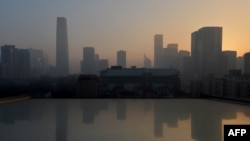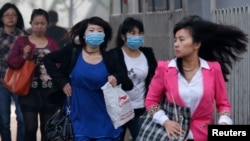The Chinese government has announced several emergency steps to combat the worsening air pollution in the capital
Record levels of smog in Beijing in recent days have led China to acknowledge an urgent need for changes to its rapid economic growth model.
The Chinese government also has taken other actions to combat the worsening air pollution in the capital in recent years. But some Chinese policies seem to have made matters worse, and others appear to lack proper enforcement.
The Chinese government also has taken other actions to combat the worsening air pollution in the capital in recent years. But some Chinese policies seem to have made matters worse, and others appear to lack proper enforcement.
Under one emergency measure introduced on Sunday, Beijing’s environmental protection bureau suspended construction at 28 building sites around the city.
China’s official Xinhua news agency said the bureau also ordered 54 manufacturers to reduce their emissions of polluting gases by 30 percent. It said one factory operated by Beijing Hyundai Motor Company shut down completely.
While such steps may help to reduce the smog in the short run, China faces a much bigger challenge in dealing with the root causes of the problem. Some of those are beyond the government’s immediate control, such as environmental conditions that trap pollutants in the atmosphere.
While such steps may help to reduce the smog in the short run, China faces a much bigger challenge in dealing with the root causes of the problem. Some of those are beyond the government’s immediate control, such as environmental conditions that trap pollutants in the atmosphere.
The current smog crisis in Beijing came about when an unusual winter weather system brought fog and light winds to the region. That combination prevented the smog from dispersing, but forecasters expect the winds to pick up by Wednesday.
Too many skyscrapers
Ping He, head of the Washington-based International Fund for China's Environment, said another problem for the Chinese capital is the density of its skyscrapers.
“There is not enough space and green land between the buildings, so the trapped pollution does not have room to flow around,” he told VOA's Michael Lipin. “That definitely has some impact on the air quality in the downtown area.”
Beyond the city center, the mountains around Beijing act as a barrier that contains the smog.
The Chinese government has focused its anti-smog policies on the man-made causes that emit pollutants into the air.
One of the key causes is exhaust fumes from Beijing’s five million vehicles, many of them private cars, whose popularity is on the rise.
Dominic Meagher, an economist with the China Policy Institute in Beijing, said authorities have tried to control the number of new cars on the streets.
“Sometimes it can take up to two years to drive a new car, just because you have to go into a lottery to get a license plate,” he told VOA. “So the authorities do a lot to limit traffic.”
Too many older vehicles
Ping He said the Beijing municipality also has tightened standards for vehicle emissions. “Beijing has among the highest emission standards in China for new vehicles," he said, "compatible with those of the European Union.”
But the environmental fund president said the Chinese capital also is filled with exhaust from many older, higher-emission vehicles that the government has not yet replaced.
Coal burning also is a major contributor to Beijing’s smog problem.
Chinese power plants burn the fossil fuel throughout the year to generate electricity for the capital’s rapidly growing infrastructure. Beijing residents also burn coal at home to keep themselves warm in winter.
Jennifer Turner, a China environment analyst at Washington’s Woodrow Wilson Center, said China has done an “admirable” job of moving coal-fired power plants out of Beijing since before the 2008 Olympics. She adds that China also has been developing new coal plants that are among the most efficient in the world.
Growth causes more pollution
“The challenge is that that they already had a lot of coal plants, and they have been building more,” Turner said. “Electricity use has been surging for the past 20 years and China needs the energy to keep its economy going.”
China also has relocated high-polluting factories such as steel producers away from Beijing during the past decade. In their place, Ping He said, many small manufacturing plants have emerged in the region. “The emissions (of those factories) are subject to strict environmental controls and standards, but they are not implemented effectively,” he said.
Turner said one weakness of those regulations is that some reporting of emissions data by manufacturers is voluntary.
“The Chinese ministry of environmental protection’s data-reporting system needs more teeth, and the companies need to be made more accountable,” she said. The analyst noted that recent improvements in the quantity of air-pollution data that the government releases to the public may help to achieve that accountability.
Since last year, China has been releasing information about the most dangerous air pollution particles in more than 70 cities- and started issuing hourly updates in some cases.
“Having hourly data limits the opportunity for data to be tampered with, and it really can be quite empowering to the communities,” Turner said.
“Chinese citizens and environmental groups are ever more eagerly playing the role of watchdog. That could really help the government in enforcing regulations and imposing fines on companies exceeding their emission limits.”
Victor Beattie contributed to this report.








